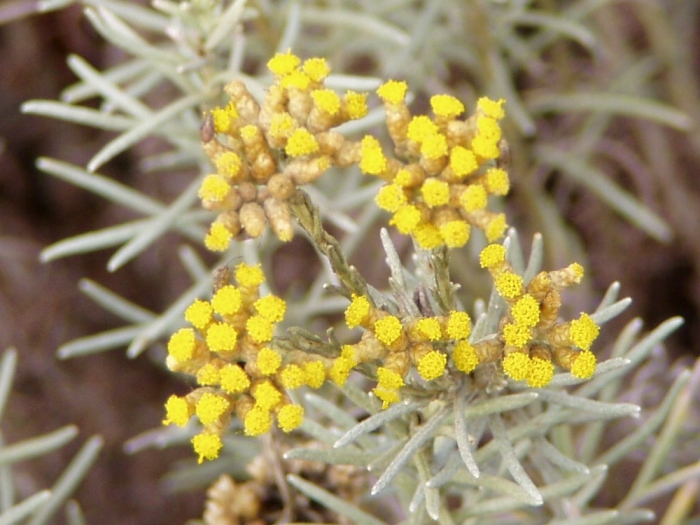Curry Plant
(Helichrysum italicum)
Curry Plant (Helichrysum italicum)
/
/

Júlio Reis
CC BY-SA 3.0
Image By:
Júlio Reis
Recorded By:
Copyright:
CC BY-SA 3.0
Copyright Notice:
Photo by: Júlio Reis | License Type: CC BY-SA 3.0 | License URL: https://creativecommons.org/licenses/by-sa/3.0 | Uploader: Tintazul | Publisher: Wikimedia Commons | Title: Helichrysum_italicum_flowers.jpg | Notes: {{Information |Description=This is an uncategorized photograph. I will add the full description soon. |Source=Own Picture. |Date=Saturday, September 9, 2006 |Author=Photo (c)2006 Derek Ramsey ([[:en:User:Ram-Man|Ram-Man]]) |Permission=You may '''NOT''' |





















































Estimated Native Range
Summary
Helichrysum italicum, commonly known as the curry plant, is a tender perennial herb native to rocky and sandy terrain in the Mediterranean region. It is a member of the Asteraceae family and is characterized by its silvery-grey foliage and woody stems at the base, reaching up to 60 centimeters (24 inches) in height. The plant produces clusters of small, bright yellow flowers in summer, which are notably showy and retain their color when dried, making them popular in dried flower arrangements. The leaves emit a strong curry-like fragrance when brushed or crushed.
The curry plant is valued for its drought tolerance and aromatic foliage, which adds both visual and sensory appeal to gardens. It is often used in rock gardens, herb gardens, and as an ornamental border due to its compact size and interesting texture. Helichrysum italicum thrives in full sun and well-drained soils, preferring low water once established, making it suitable for xeriscaping. While it is generally easy to maintain, it requires protection from frost and can be propagated by rooting semi-hardwood cuttings in summer. Overwintering in frost-free conditions is essential in cooler climates.CC BY-SA 4.0
The curry plant is valued for its drought tolerance and aromatic foliage, which adds both visual and sensory appeal to gardens. It is often used in rock gardens, herb gardens, and as an ornamental border due to its compact size and interesting texture. Helichrysum italicum thrives in full sun and well-drained soils, preferring low water once established, making it suitable for xeriscaping. While it is generally easy to maintain, it requires protection from frost and can be propagated by rooting semi-hardwood cuttings in summer. Overwintering in frost-free conditions is essential in cooler climates.CC BY-SA 4.0
Plant Description
- Plant Type: Shrub
- Height: 1-2 feet
- Width: 2-3 feet
- Growth Rate: Moderate
- Flower Color: Yellow
- Flowering Season: Spring, Summer
- Leaf Retention: Evergreen
Growth Requirements
- Sun: Full Sun
- Water: Low
- Drainage: Medium, Fast
Common Uses
Bee Garden, Butterfly Garden, Deer Resistant, Drought Tolerant, Erosion Control, Fire Resistant, Fragrant, Groundcover, Low Maintenance, Potted Plant, Rabbit Resistant, Salt Tolerant, Showy Flowers, Street Planting
Natural Habitat
Rocky and sandy terrain in the Mediterranean region
Other Names
Common Names: Italian Strawflower, Immortelle, Curryplant, Currystrauch, Curryeternell
Scientific Names: , Helichrysum italicum, Gnaphalium glutinosum var. glutinosum, Helichrysum italicum var. ericoaedeum, Helichrysum italicum var. italicum, Helichrysum italicum var. numidicum,
GBIF Accepted Name: Helichrysum italicum (Roth) G.Don